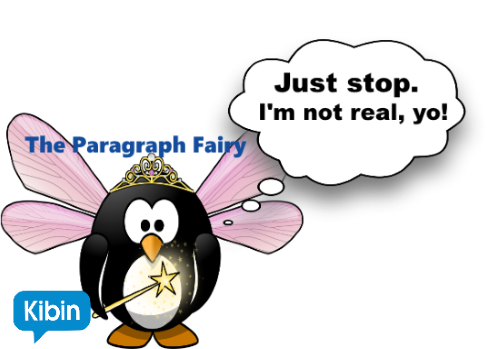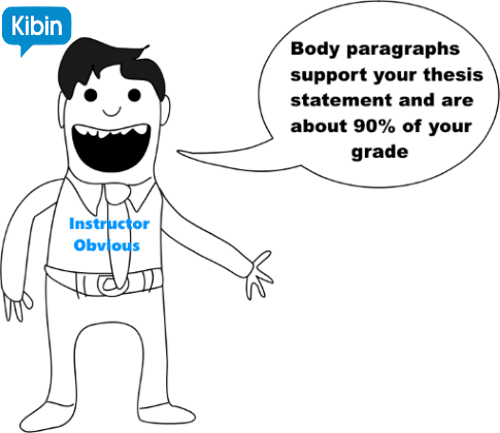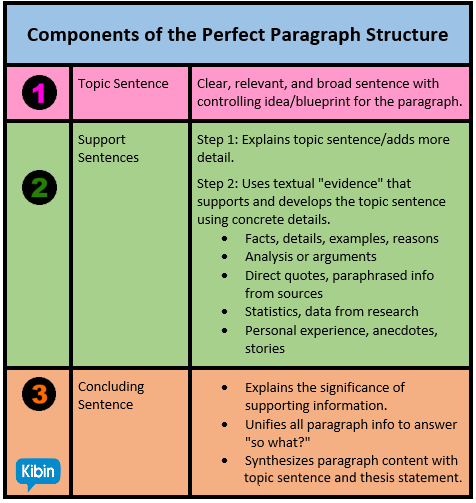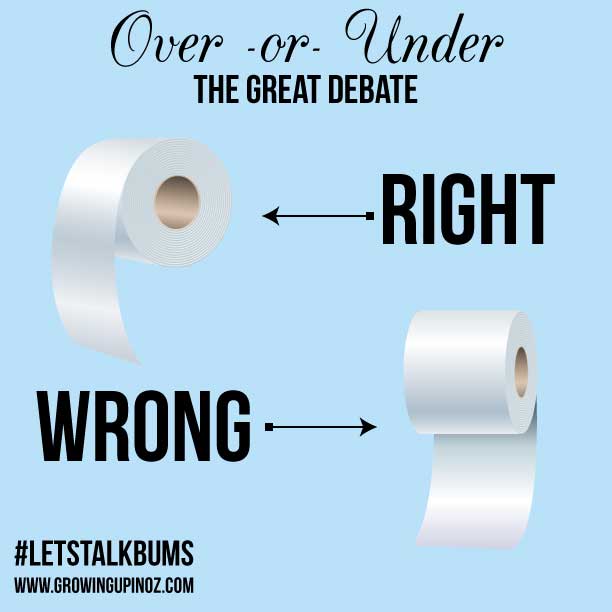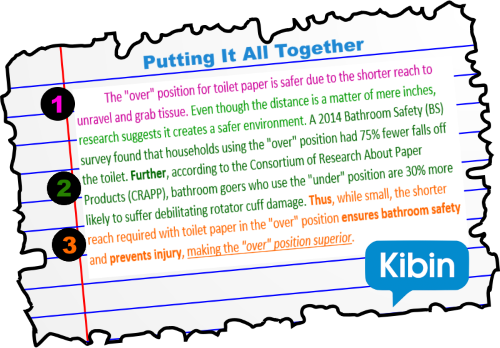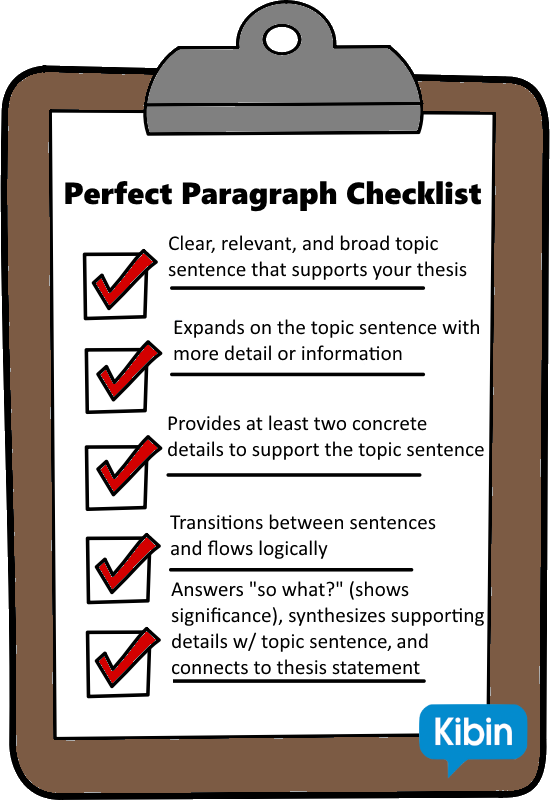You’ve done all the leg work—identified your topic, crafted the perfect thesis statement, researched like crazy, and prepared your outline. Now you sit staring at a blank screen ready to put it all together.
Maybe you’ve already written an introduction, maybe not. In either case, diving into your body paragraphs, crafting the perfect paragraph structures, is next on the agenda.
You might be wishing for a little pink-winged paragraph fairy to wave his magic wand and transform your outline into beautifully constructed paragraphs…
I had to face that hard reality, too, when writing this blog post. But it’s OK. Writing strong paragraphs with good structures is a process you can tackle. I promise.

The secret is in using “evidence” to support your main ideas and package it all in a fail-safe structure. In this blog post, I’ll break down the anatomy of the perfect paragraph structure. I’ll leave you with a blueprint to tackle all your academic paragraphs—no magic or cute little fairies needed.
First, though, let’s look at why paragraph structure is so important. Ready?
Why Paragraph Structure Matters—A Lot
The right paragraph structure for body paragraphs is important for several reasons.
Thanks, Instructor Obvious, we probably figured that out from your essay prompt. The obvious aside, good paragraph structure allows you to group and organize your main ideas into body paragraphs. These paragraphs, then, “prove” your thesis statement.
They give your essay credibility—regardless of the type of essay you’re writing. They allow readers (and the most important reader—your instructor) to grasp your main ideas. Finally, your body paragraphs flush out the logic and support for your thesis statement.
And, yes, as Instructor Obvious so deftly pointed out, they do account for a major chunk of your essay grade.
To start crafting effective paragraphs, you first need to understand all the pieces that fit together to form a cohesive paragraph structure. Let’s jump in, shall we?
The Components of the Perfect Paragraph Structure
Every academic paragraph structure has three main components:
- Topic sentence
- Support sentences
- Concluding sentence
A paragraph, according to Merriam-Webster.com, is “a part of a piece of writing that usually deals with one subject, that begins on a new line, and that is made up of one or more sentences.”
While that doesn’t help us much in terms of structure, it does highlight one key point: A paragraph deals with one main idea.
Each paragraph in any academic essay should have one—and only one—main point. This highlights the first component of the perfect paragraph structure, the topic sentence.
The second component comprises the support sentences. These sentences establish the proof of, and develop, your main idea.
The third component, the concluding sentence, then brings the first two components together. It synthesizes the main idea with the proof to show why it matters.
I’ve put the three main components in a handy table for you with more detail about what each entails:
Let’s break those down even more and practice with an example paragraph.
Paragraph Structure Component #1: Topic Sentence
The topic sentence presents both the topic and the controlling idea of your paragraph. It also accomplishes three crucial things:
- It connects to and supports your thesis statement.
- It establishes what the paragraph is about.
- It unifies the content of the paragraph.
Think of the topic sentence as a mini-thesis. Everything in the rest of the paragraph must relate back to it. A good topic sentence is clear and relevant to your thesis statement.
There’s one caveat here. Make sure the topic sentence is specific enough to connect to your thesis statement and provide a writable blueprint for the paragraph. But also make sure it’s broad enough that the details within it don’t make it hard to write an entire paragraph.
Let’s build an example of the first component of the perfect paragraph structure.
Assume my thesis statement says this:
The “over” position for toilet paper is superior because it is safer due to a shorter reach to unravel and grab tissue, it limits the spread of germs, and it is more visually appealing.
(I don’t know about you, but in my house, the position of toilet paper is a serious point of contention. It’s sparked many debates and heated “discussions.”)
My topic sentence might look something like this:
The “over” position for toilet paper is safer due to the shorter reach to unravel and grab the tissue.
Comparing against the three things a topic sentence should do, my example does the following:
![]() Connects to and supports the thesis statement.
Connects to and supports the thesis statement.
![]() Establishes what the paragraph is about.
Establishes what the paragraph is about.
![]() Unifies the content of the paragraph (which you’ll see in the next section!).
Unifies the content of the paragraph (which you’ll see in the next section!).
This topic sentence sets up the lead-in to the details that form the support sentences, the second component of the perfect paragraph structure.
Paragraph Structure Component #2: Support Sentences
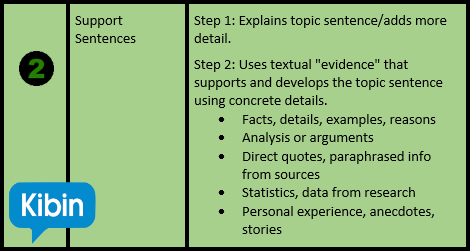
Support sentences are vital to supporting both your topic sentence and your thesis statement. These sentences will accomplish three things:
- They add more detail to and/or explain your topic sentence.
- They use concrete details as “evidence” to prove, clarify, or illustrate your main point.
- They give your paragraph meaning.
How you develop the support sentences will depend on the type of essay you’re writing, though. While there are many approaches to paragraph development , answering a few questions can help you figure out what approach is best for your essay topic and structure.
- Will examples, details, or reasons support your point?
- Do you need to analyze information or argue a point?
- Will quoting research help establish your point?
- Do you have relevant statistics or other research data available?
- Can or should you tie in personal experience?
By answering these questions, you can start to shape how you will develop the paragraph to create the perfect paragraph structure. Use at least two concrete details to make your paragraph effective. You can use more—let your topic and the amount of support it needs dictate that for you.
If you need to analyze information from research, for example, your paragraph will likely be longer. While there’s no set number of sentences you need to include, aim for 5-8 sentences. This ensures you don’t make paragraphs too long but still have sufficient details and content to establish the main support for the topic sentence.
You also want to present support sentences logically and systematically. For example, you don’t want to present research first and then further explain your topic sentence. The paragraph development method you select will guide you in this process.
Now, let’s break the support sentences into two steps.
First, I want to further explain my topic sentence and add a little more detail. I might create a sentence that looks something like this:
Even though the distance is a matter of mere inches, research suggests it creates a safer environment.
Then, as the second step, I want to provide the evidence that supports my topic sentence and, by extension, my thesis, too. I’ll use research data and statistics to argue my point—that the “over” position for toilet paper is superior because it’s safer.
I might construct two additional support sentences that look like this:
A 2014 Bathroom Safety (BS) survey found that households using the “over” position had 75% fewer falls off the toilet. Further, according to the Consortium of Research About Paper Products (CRAPP), bathroom goers who use the “under” position are 30% more likely to suffer debilitating rotator cuff damage.
Notice how I’ve put “further” in bold? This highlights the importance of transitioning between your support sentences. Just throwing in a series of rapid-fire sentences hurts the flow of information. So make sure you use transitions well to create continuity and unity, which together will build good flow.
Comparing against what support sentences should do, my sentences do the following:
![]() Add more detail to the topic sentence.
Add more detail to the topic sentence.
![]() Use concrete details as evidence.
Use concrete details as evidence.
Don’t just stuff facts or details into a paragraph, though. You need to show why the information is important.
The concluding sentence allows you to do this in a nice neat bow to wrap up the paragraph.
Paragraph Structure Component #3: Concluding Sentence
The concluding sentence lets you show the “why.” You provided the “evidence,” but why do the details matter?
The concluding sentence accomplishes three things:
- It shows the significance of the information.
- It answers the “so what?” question.
- It synthesizes your paragraph content with your topic sentence.
In other words, you want to use wording that reinforces the main idea in your topic sentence and draws the information you presented together with that main idea. This means using similar wording (but not just restating) from your topic sentence. It also means reinforcing the relevance of the paragraph to your thesis statement.
My example concluding sentence might look something like this:
Thus, while small, the shorter reach required with toilet paper in the “over” position ensures bathroom safety and prevents injury, making the “over” position superior.
Notice a few key things here that help reinforce the paragraph structure. First, I used a transitional word (“thus”) to shift into the concluding sentence.
Second, I used wording that mirrors my topic sentence (“shorter reach,” “ensures bathroom safety,” and “prevents injury”).
Third, the end of the sentence relates the paragraph back to my thesis statement with “making the ‘over’ position superior.”
Comparing against what a concluding sentence should do, my sentence does the following:
![]() Explains the significance of the information (answers the “so what?” question).
Explains the significance of the information (answers the “so what?” question).
![]() Synthesizes the supporting details with the topic sentence.
Synthesizes the supporting details with the topic sentence.
![]() Connects to your thesis statement.
Connects to your thesis statement.
Now, let’s put it all together to view the final paragraph to see how the perfect paragraph structure looks with a full example:
That wasn’t so bad, was it? If you follow the simple steps I’ve outlined and choose the right method of paragraph development, you will craft the perfect paragraph structure every time.
See? You don’t need the paragraph fairy after all.
Perfect Paragraph Structure Checklist
Before I send you off into the wild to write perfect paragraphs for your next essay, here’s a checklist you can use to help keep your paragraph structure on track.
Need More Help Creating Perfect Paragraph Structure?
If you’re still feeling a little unsure about creating the perfect paragraph structure, check out this handout from the UNC Writing Center, try the P.I.E. approach, or read this blog on paragraph development.
If you’re feeling adventurous, look at some example essays that are similar to your assigned essay and compare them against the perfect paragraph checklist. This will give you an idea of what you should or shouldn’t do when crafting your own paragraphs for a specific essay type.
If you’ve got your first essay draft done and want reassurance or additional guidance, send your essay to a Kibin editor to check for paragraph structure and development (and a whole lot more!) because that’s how we roll (har har).
And if the Great Toilet Paper Debate is a hotly contested issue in your house, you can quiet those naysayers to the “over” position, too. A look at the image submitted with the patent for the first toilet paper holder clearly shows the “correct” position.
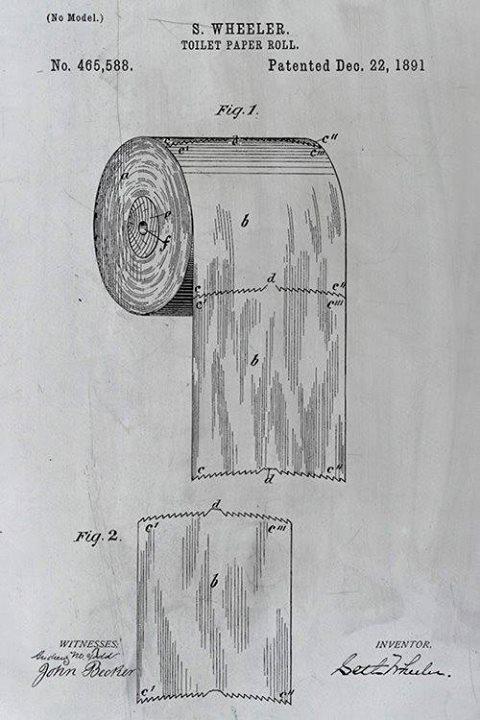
With that, I bid you adieu. Here’s to happy, stress-free writing AND safe bathroom expeditions!
